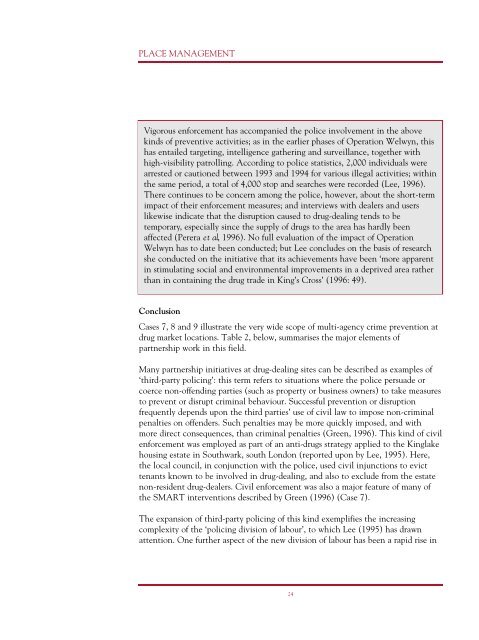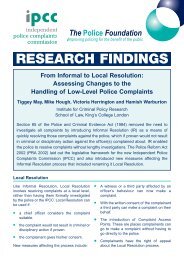Policing Drug Hot-Spots - Center for Problem-Oriented Policing
Policing Drug Hot-Spots - Center for Problem-Oriented Policing
Policing Drug Hot-Spots - Center for Problem-Oriented Policing
Create successful ePaper yourself
Turn your PDF publications into a flip-book with our unique Google optimized e-Paper software.
PLACE MANAGEMENTVigorous en<strong>for</strong>cement has accompanied the police involvement in the abovekinds of preventive activities; as in the earlier phases of Operation Welwyn, thishas entailed targeting, intelligence gathering and surveillance, together withhigh-visibility patrolling. According to police statistics, 2,000 individuals werearrested or cautioned between 1993 and 1994 <strong>for</strong> various illegal activities; withinthe same period, a total of 4,000 stop and searches were recorded (Lee, 1996).There continues to be concern among the police, however, about the short-termimpact of their en<strong>for</strong>cement measures; and interviews with dealers and userslikewise indicate that the disruption caused to drug-dealing tends to betemporary, especially since the supply of drugs to the area has hardly beenaffected (Perera et al, 1996). No full evaluation of the impact of OperationWelwyn has to date been conducted; but Lee concludes on the basis of researchshe conducted on the initiative that its achievements have been ‘more apparentin stimulating social and environmental improvements in a deprived area ratherthan in containing the drug trade in King’s Cross’ (1996: 49).ConclusionCases 7, 8 and 9 illustrate the very wide scope of multi-agency crime prevention atdrug market locations. Table 2, below, summarises the major elements ofpartnership work in this field.Many partnership initiatives at drug-dealing sites can be described as examples of‘third-party policing’: this term refers to situations where the police persuade orcoerce non-offending parties (such as property or business owners) to take measuresto prevent or disrupt criminal behaviour. Successful prevention or disruptionfrequently depends upon the third parties’ use of civil law to impose non-criminalpenalties on offenders. Such penalties may be more quickly imposed, and withmore direct consequences, than criminal penalties (Green, 1996). This kind of civilen<strong>for</strong>cement was employed as part of an anti-drugs strategy applied to the Kinglakehousing estate in Southwark, south London (reported upon by Lee, 1995). Here,the local council, in conjunction with the police, used civil injunctions to evicttenants known to be involved in drug-dealing, and also to exclude from the estatenon-resident drug-dealers. Civil en<strong>for</strong>cement was also a major feature of many ofthe SMART interventions described by Green (1996) (Case 7).The expansion of third-party policing of this kind exemplifies the increasingcomplexity of the ‘policing division of labour’, to which Lee (1995) has drawnattention. One further aspect of the new division of labour has been a rapid rise in24






